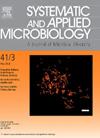Rhizobium binxianense sp. nov. and Rhizobium mulingense sp. nov., isolated from nodules of Phaseolus vulgaris in Heilongjiang Province of China
IF 4.2
2区 生物学
Q2 BIOTECHNOLOGY & APPLIED MICROBIOLOGY
引用次数: 0
Abstract
Rhizobial isolates from Phaseolus vulgaris (common bean) grown in Heilongjiang Province were grouped into two clusters based upon the phylogenies of 16S rRNA and recA-atpD genes representing by BJ04T, MJ22, MJ37, BC56, MC62 and MC63T, MJ21, MJ31, respectively. The phylogenetic analysis of whole genomes further revealed that BJ04T, MJ22, MJ37, BC56 and MC62 formed a cluster neighbored Rhizobium chutanense C5T, while MC63T, MJ21 and MJ31 formed a cluster most related with Rhizobium croatiense 13TT. The whole genome average nucleotide identity (ANI) and digital DNA–DNA hybridization (dDDH) values between the strains BJ04T and R. chutanense C5T and between MC63T and R. croatiense 13TT were lower than the species thresholds 95 % and 70 %, respectively. While the G + C content of the whole genome of the novel strains were 61.16–61.56 %, within the allowable GC content range of the Rhizobium genus (57–66 %). These results, combined with chemical classification and phenotype analysis, supported that BJ04T and MC63T represented two novel species and the names Rhizobium binxianense sp. nov. and Rhizobium mulingense sp. nov. were described for them. BJ04T (=CCTCC AB 2022367T, = JCM 35885T) and MC63T (=CCTCC AB 2024025T, = JCM 36652T) were designed as the type strains, respectively for these two novel species.
从黑龙江省菜豆根瘤中分离的滨咸根瘤菌和mulingense根瘤菌
根据16S rRNA和recA-atpD基因(分别为BJ04T、MJ22、MJ37、BC56、MC62和MC63T、MJ21、MJ31)的系统发育特征,将黑龙江省菜豆根瘤菌分离物分为两类。全基因组系统发育分析进一步表明,BJ04T、MJ22、MJ37、BC56和MC62与chuutanense C5T形成一个集群,而MC63T、MJ21和MJ31与克罗地亚根瘤菌13TT形成一个集群。菌株BJ04T与楚坦纳河鼠C5T、MC63T与克罗地亚纳河鼠13TT的全基因组平均核苷酸同源性(ANI)和数字DNA-DNA杂交(dDDH)值分别低于种间阈值95%和70%。新菌株全基因组G + C含量为61.16 ~ 61.56%,在根瘤菌属允许的GC含量范围(57 ~ 66%)内。这些结果结合化学分类和表型分析,支持BJ04T和MC63T为两个新种,并为它们命名为binxianense sp. 11和mulingense sp. 11。将BJ04T (=CCTCC AB 2022367T, = JCM 35885T)和MC63T (=CCTCC AB 2024025T, = JCM 36652T)分别设计为这两个新种的型菌株。
本文章由计算机程序翻译,如有差异,请以英文原文为准。
求助全文
约1分钟内获得全文
求助全文
来源期刊

Systematic and applied microbiology
生物-生物工程与应用微生物
CiteScore
7.50
自引率
5.90%
发文量
57
审稿时长
22 days
期刊介绍:
Systematic and Applied Microbiology deals with various aspects of microbial diversity and systematics of prokaryotes. It focuses on Bacteria and Archaea; eukaryotic microorganisms will only be considered in rare cases. The journal perceives a broad understanding of microbial diversity and encourages the submission of manuscripts from the following branches of microbiology:
 求助内容:
求助内容: 应助结果提醒方式:
应助结果提醒方式:


